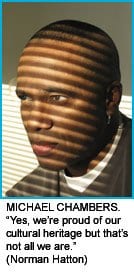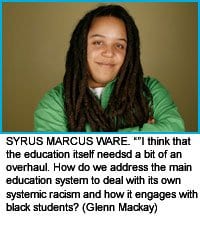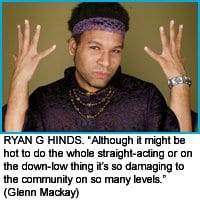It is often the way of articles written in honour of Black History Month to look at figures of note from our past solely through the lens of their struggle against racism. To do the same with contemporary queer black activists is far too simplistic — it is like asking them to choose between coping with racism, homophobia, sexism or transphobia. Yet you need only look as far as the reaction to Barack Obama and the race for the US Democratic presidential ticket to see how quickly race can be seen to override other identities.
The following four individuals, all leaders in their respective arenas, know well the challenges of juggling multiple labels. Artists and activists, they have each made contributions to black visibility in Toronto’s queer scene and found unique ways to bridge the gaps between cultures. They spoke with Xtra about their experiences and offered comment on one of the pressing issues of the day — the creation of Africentric schools in Toronto.
LORELEI KING
Born in Cape Breton, Lorelei King has been working at Supporting Our Youth (SOY) since 2005 when she joined as a drop-in facilitator. Since January 2007 she’s been the community programs coordinator, which includes facilitating Black Queer Youth (BQY), a social and support group for black youth ages 14 to 29.
“If there was a BQY when I was growing up I would have flocked to it,” says King, “because it gives a voice, it gives recognition, it gives validity…. It’s a warm, welcoming and very important space and I’m proud to be a part of it.”
King says her approach with BQY has been to promote ownership versus membership. In this way she hopes youth will discover for themselves what is available to them and how to find funding for the initiatives they want to undertake — which includes a zine project that launches this month.
“They should know where the tokens and the pizzas come from,” says King with a laugh.
King is also active with Pride Toronto. Part of her job with SOY includes coordinating this year’s Fruit Loopz stage, a space for queer youth to express themselves through performance. She also volunteers as a member of Pride’s disability committee. For King the decision to join the committee was personal; having lost her left eye to cancer at age three she knows what it’s like to live with a disability.
“I find the queer community is more tolerant of the needs of the disabled, that less is taken for granted,” says King, “but there is isolation, there is still judgment and preference. In both the straight and queer world being perfect is the priority.”
Through her experiences and from hearing about those of BQY members King says racism is still prevalent in the queer scene — and on Church St in particular — but she also thinks it’s handled differently than it used to be.
“As people of colour we learn and grow in the community and become more tolerant and learn how to use our voices in regards to advocating around racial issues, so I think that’s changed. The image of the black queer person is no longer as much this angry black person who you fear.”
King says she’d like to see more discussion of difference as a way to find unity.
“Don’t say that you’re colour blind, don’t say that you don’t notice, ’cause there are differences,” says King. “Welcome those differences, acknowledge those differences and learn about them.
“I don’t want to sound corny but I promote unity. In Kwanzaa it’s called ‘umoja,’ and that’s not just about rainbows, it’s about knowing politics. For example there’s a black man who wants to be US president. Even if you’re a person of colour, don’t vote for him just because he’s a black man. Pay attention to what he’s saying because he might not have any interest in you, as a queer black person.”
King says she’s not opposed to Africentric schools but questions the Toronto District School Board’s reluctance to make lesson plans in all schools more inclusive.
“Why can’t they integrate a curriculum that includes black culture and history in the regular school?” asks King. “Why is that so difficult?”
MICHAEL CHAMBERS
Jamaican-born photographer Michael Chambers uses his work to try to convey the change he wants to see in the world, tackling questions of inclusion and exclusion in all sorts of socially constructed categories.
“My work has always been about addressing people and issues dealing with being stereotyped — being put in a category based on ethnicity, so-called colour or race, gender, sexuality and basically anything,” says Chambers. “People feel the need to marginalize based on their need to identify.
“When we reach out and address the concept of race we’re generally suggesting exclusion,” adds Chambers. “I’m saying, ‘It is the human race, so let’s be more inclusive.'”
Internationally exhibited, Chambers was the recipient of the 2007 Word Arts Award in photography and the 2000 Mosaic Image Award, and has been honoured by the National Film Board of Canada. His spare and haunting photographs have led community groups, including the AIDS Committee of Toronto and Oxfam, to enlist Chambers to help tell their stories through poster campaigns.
Currently Chambers is expanding on a project he began four years ago, originally exhibited at Harbourfront Centre under the title The Sandbox. The project began by asking a group of 11-year-olds of colour to explain in their words the ways in which they are special.
“I didn’t want the question to be leading,” says Chambers, “so instead of asking, ‘What is it like to be different?’ I asked how do they feel special. Without any more information they all broke it down to identity, culture and race.”
The resulting exhibit combined photographs of kids age two to 14 who identified with African roots but came from a variety of ethnicities and racial backgrounds. Chambers references historical head count policies by which individuals who had even one known African ancestor were simply identified as black.
“My exhibit was really a contradiction of that, saying we are a people of cultural diversity. We might look a certain way but there’s more to us. Yes we’re proud of our cultural heritage but that’s not all we are.”
Similarly Chambers wants to see society get beyond stereotypes when it comes to sexuality and emphasize shared experience rather than difference.
“Why are we so concerned with who someone is capable of loving rather than their ability to love?” asks Chambers. “Reciprocated love is a gift and some people never get to experience that in their lives.”
Chambers says he feels that Toronto’s queer scene has become more welcoming of racial diversity.
“It has to do with confidence,” says Chambers. “It has to do with people standing up and feeling counted and realizing that we are individuals of value.”
Chambers, who is a guest lecturer at institutions including the Ontario College of Art and Design and the Art Gallery of Ontario, also runs workshops on art at high schools in the GTA, including workshops for at-risk kids. He says he’s in favour of giving Africentric schools a chance.
“It’s about celebrating our cultural heritage not just for kids of African origin,” adds Chambers. “We should stand tall and actually include our African history as part of Canadian history. I think there is a place for it but it should go right across the board.”
SYRUS MARCUS WARE
Visual artist Syrus Marcus Ware was named best queer activist by Now Magazine in 2006 — with good reason. The list of Ware’s contributions is long; many meld activism with art.
For the past 10 years Ware has been host of CIUT 89.5 FM’s Resistance on the Sound Dial. “It’s been great,” says Ware. “I’ve had a chance to talk to some really interesting people doing activism and resistance,” including members of Ghana’s Marcus Garvey Youth League and New Zealand’s Georgina Beyer, the first openly trans member of parliament anywhere in the world.
Ware is also a part of the Gay Bi Queer Transmen Working Group (TWG). Formed in 2006 by the AIDS Bureau of Ontario, TWG’s goal is to provide sexual health information to trans guys who have sex with men. TWG’s sexual health guide, Primed: The Back Pocket Guide for Transmen and the Men Who Dig Them, has drawn interest from groups as far away as Australia and is soon to be translated for distribution in Germany.
Ware is so visible in the queer and trans scenes that it is easy to confuse his activism with his personal life. Such was the case when he was part of a photo illustration for an Xtra article on TransFathers 2B, a pilot course he helped develop for trans men considering parenting. The course was the first of its kind in Canada.
“I had a pretend bump,” says Ware, adding that people have been asking after the baby ever since. “I never thought it would cause such a ripple.”
In addition to his work on trans issues Ware is also involved with antiprison activism. In 2001 his involvement around Mumia Abu-Jamal — a black US activist who is widely believed to have been unjustly convicted in the 1981 murder of a Philadelphia cop — led Ware to work with the Prisoners with HIV and AIDS Support and Action Network, helping to organize Prisoners Justice Day, an annual vigil held on Aug 10 to commemorate the deaths of prisoners due to inadequate healthcare on the inside.
In 2004 Ware helped to form the Prisoners’ Justice Action Committee, “to do ongoing work throughout the year… responding to and developing a prisoners’ rights movement that was representative of marginalized communities — indigenous people, people of colour, queer, transgendered — all of whom are overrepresented in prisons.”
As if all that wasn’t enough Ware is also involved with Blackness Yes, the group behind Blockorama.
“Traditionally there’s a lot of particular communities that have been marginalized within the larger Pride festivities. Blockorama is about making space for black queer and trans people, youth and elders to come together and celebrate our resistance, celebrate our communities, celebrate our lives.”
Watch for Raise Your Hands, a benefit for this year’s Blockorama — the 10th anniversary — and Black CAP on Fri, Feb 22 at Goodhandy’s.
Ware is not sure whether Africentric schools are the way to go. “I think that the education system itself needs a bit of an overhaul. How do we address the main education system to deal with its own systemic racism and how it engages with black students in the mainstream schools? We have a lot of work to do and we need the funding to be able to do such a curriculum overhaul.”
RYAN G HINDS
Performance artist, Artwherk festival cofounder and a dazzling dresser, Ryan G Hinds also blurs the lines between art and activism.
“I think every piece of art I’ve ever made in my life has political overtones,” says Hinds, “and so much of the activism I’ve done in my life comes through a place of me being a creative person, whether it’s through a really ornate sign or through my wardrobe choices being the statement that I make to get attention around a particular issue.”
In 2005 Hinds cofounded Artwherk, an annual queer youth arts festival that takes place Pride Week. “We did it one year and it went really well and it’s snowballed,” says Hinds.
A regular performer at venues like Buddies in Bad Times and the Gladstone — he’s performing a tribute to black gay ’70s superstar Sylvester at Buddies on Fri, Feb 15 as part of the Screww retro party — Hinds says it’s been harder for him to break into traditional theatre.
“My whole life — even now, unfortunately, a little bit — people have always told me I’m too black to be in this show or I’m not black enough to be in this show. So with my performance stuff I want to get beyond that. I don’t want to make black performance art or not black performance art. I just want to do my performances and just make them the statements that they are.”
Raised in Mississauga Hinds says he was very aware of being different from his classmates.
“I was the only person of colour in my class for a long time, until I got to Grade 6 or 7, and I was very obviously queer at that age too,” says Hinds. “That was, not necessarily a lonely place, but an informative place because I didn’t have that common ground with a lot of other people that I went to school with. So instead I got comfortable in my own body and in my own mind.”
Hinds, who came out at age 13, says he was hit hard by the story of Shaquille Wisdom, a 13-year-old black kid from Ajax who committed suicide last October after being the target of homo-phobic bullying.
“Shaquille and I, we were totally in different head spaces,” says Hinds, “and I’ve thought, ‘What would have changed his mind?’ What would’ve put him in a better headspace? If he knew other queer kids his age? If he’d known of other queer black men in history? Would that have given him some sense of pride and some sense of having a lineage, to not have done what he did?”
It’s a reminder of how important it is to be out and proud, says Hinds, “especially if you’re a racialized person, especially if you’re of a background that doesn’t necessarily embrace it. That just makes it all the more important. Although it might be hot to do the whole straight-acting thing or on the down-low thing it’s so damaging to the community on so many levels.”
Hinds comes down against the proposed Africentric schools. “I don’t think Africentric schools are the solution,” he says. “Public schools need a drastic overhaul to improve and equalize the curriculum, not just for black students but for all marginalized students…. I understand the need for safe spaces, but I think there’s a way we can make them for everyone instead for divided groups of people.”



 Why you can trust Xtra
Why you can trust Xtra


